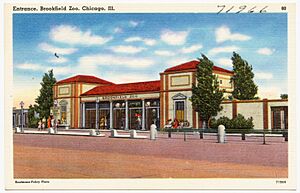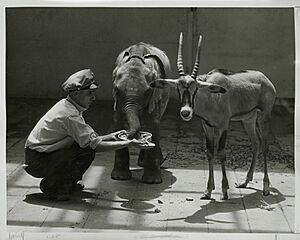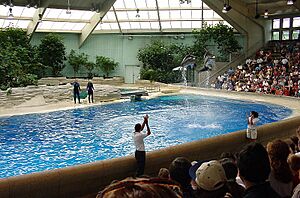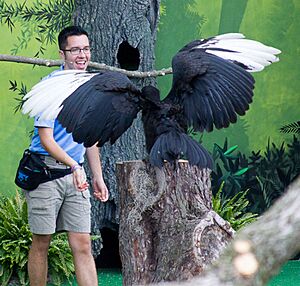Brookfield Zoo Chicago facts for kids
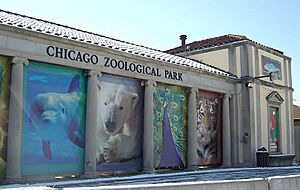
Brookfield Zoo Chicago, North Gate
|
|
| Date opened | July 1, 1934 |
|---|---|
| Location | Brookfield, Illinois, United States |
| Land area | 235 acres (95 ha) |
| Coordinates | 41°49′58″N 87°50′00″W / 41.832671°N 87.833462°W |
| No. of animals | 3,481 |
| No. of species | 511 |
| Annual visitors | 2 million |
| Memberships | AZA |
Brookfield Zoo Chicago is a famous zoo in Brookfield, Illinois. Until 2024, it was simply called Brookfield Zoo. It is also known as the Chicago Zoological Park. The zoo is owned by the Forest Preserve District of Cook County. The Chicago Zoological Society manages it.
Brookfield Zoo Chicago is the biggest zoo in the Chicago metropolitan area. It is home to about 511 different kinds of animals. The zoo covers a large area of 216 acres (87 ha). It first opened its doors on July 1, 1934.
The zoo quickly became famous around the world. It used moats and ditches instead of cages for animals. This was a new and exciting idea. Brookfield Zoo was also the first zoo in the United States to show giant pandas. One of these pandas, named Su Lin, is now on display at Chicago's Field Museum of Natural History.
In the 1960s, the zoo opened the first indoor bottlenose dolphin exhibit in the country. Later, in the 1980s, it created the first indoor tropical rainforest exhibit. This was the largest indoor zoo exhibit in the world at that time. Brookfield Zoo Chicago is often named as one of the best zoos in the United States.
Contents
History of Brookfield Zoo
The Early Years: 1900s
In 1919, Edith Rockefeller McCormick gave some land for a zoo. She received this land from her father as a wedding gift. The Cook County Forest Preserve District received the land. They added 98 acres (400,000 m2) more land to the plot.
In 1921, the Chicago Zoological Society was created. Building the zoo did not start until 1926. This was after a special zoo tax was approved. Construction slowed down during the Great Depression. But it picked up speed again by late 1931.
The zoo opened on July 1, 1934. By the end of September 1934, over one million people had visited. By 1936, four million people had come to the zoo.
The 1950s brought new additions to the zoo. A veterinary hospital was built. A children's zoo also opened. The Roosevelt Fountain was added, named after U.S. president Theodore Roosevelt. The zoo faced some challenges in the 1960s. However, a large amount of money from the Forest Preserve District helped it grow. The zoo opened the nation's first indoor dolphinarium in the 1960s.
In the early 1980s, the zoo built Tropic World. This was an indoor exhibit that looked like a tropical rainforest. French architect Pierre Venoa designed Tropic World. It was finished in 1984.
In 1996, a three-year-old boy fell into an animal area in Tropic World. A female western lowland gorilla named Binti Jua helped the child. She stayed with him until zoo staff could rescue him. This event became famous worldwide.
Recent Times: 2000s and Beyond
In the early 2000s, the zoo made many improvements. They built the Hamill Family Play Zoo. A large wolf exhibit was also added. An interactive butterfly tent opened. New areas for group events were created. The zoo also got the largest hand-carved wooden carousel in the United States.
Great Bear Wilderness opened in 2010. This $27.3 million exhibit is home to grizzly and polar bears. Several older buildings were changed inside. They became exhibits that showed different ecosystems. These included areas like South American coasts and swamps. Other exhibits showed deserts, the African savanna, and the Australian Outback.
The zoo's reptile house was the first building to open in 1934. It closed in 2005. It was then changed into the Mary Ann McLean Conservation Leadership Center. This center does not show live animals. Instead, it teaches about the zoo's important work in conservation.
In 2011, the zoo faced protests about its African elephants. Because of this, Brookfield Zoo does not currently have elephants or Nile hippopotamus. However, the zoo plans to bring both species back in the future. The Children's Zoo opened in August 1953. It was taken down in early 2013. A new family-friendly area called Wild Encounters opened on July 1, 2015.
The zoo has closed only a few times in its history. This happened due to storms, blizzards, and flooding. It also closed for two days in 2019 because of very cold weather. From March 19 to July 1, 2020, it closed due to the COVID-19 pandemic. It also closed on January 12, 2024, because of a winter storm.
In September 2023, the zoo received a huge gift. An unknown person donated $40 million. This was the largest private donation in the zoo's history. The zoo used this money for a new expansion to Tropic World. This new area is called Tropical Forests. It will have outdoor exhibits for monkeys, gorillas, and orangutans. It will also have new indoor exhibits for them. The zoo plans to bring two new male gorillas from Zoo Miami. The opening date for Tropical Forests has not been announced yet. This project is part of Brookfield Zoo Chicago's future plans.
In 2024, a ferris wheel was set up near the east mall. This was to celebrate the zoo's 90th anniversary. It returned for the 2025 season.
Famous Animals
- Binti Jua is a female western lowland gorilla. She became famous in 1996 for helping a three-year-old child. The child had fallen into her exhibit.
- Cookie was a Major Mitchell's cockatoo. He lived at the zoo from its opening in 1934 until he passed away in 2016.
- Ziggy was a very large male Asian elephant. He weighed 6 tons. He was kept chained in the Pachyderm House for thirty years. This was because he attacked his keeper in 1941.
Animal Exhibits
- Amazing Arachnids! (2018): This exhibit features many kinds of spiders and scorpions. Some examples are the Blue femur beauty tarantula, Brazilian blue violet tarantula, Brazilian pink bloom tarantula, Brazilian red and white tarantula, Burgundy goliath birdeater, Columbian pumpkin patch tarantula, Chaco golden knee, Chilean gold dust spider, Chiricahuan grey, Curly hair tarantula, Desert hairy scorpion, Dictator scorpion, Dwarf Philippine tangerine, Emperor scorpion, Entre Rios tarantula, Feather leg baboon tarantula, Giant flat rock scorpion, Ghost ornamental tarantula, Goliath bird-eating tarantula, Goliath pinkfoot tarantula, Guatemalan tiger rump tarantula, Mahogany tree spider, Metallic pink toe tarantula, Mexican fireleg tarantula, Mexican red knee tarantula, Mozambique golden baboon tarantula, Olive keeled flat rock scorpion, Ornamental baboon tarantula, Peacock tarantula, Purple earth tarantula, Purple tree spider, Rameshwaram Temple tarantula, Skeleton leg tarantula, South Vietnam blue tarantula, Stripe knee tarantula, Tailless whip scorpion, Tiger rump tarantula, Venezuelan suntiger tarantula, Vinegaroon, Wolf spider, and Yellow-backed ornamental tiger tarantula.
- Australia: Here you can see Bennett's wallabies, brush-tailed bettongs, Cape Barren geese, emus, frilled lizards, green tree pythons, laughing kookaburras, short-beaked echidnas, southern hairy-nosed wombats, western grey kangaroos, and woma pythons.
- Big Cats: This area features powerful animals like African lions, Amur tigers, sloth bears, and snow leopards.
- Clouded Leopard Rain Forest: Home to Asian small-clawed otters, binturongs, clouded leopards, emperor newts, Prevost's squirrels, and ring-tailed lemurs.
- Desert's Edge: Discover animals from dry places, including Amur leopards, Arabian sand cats, bat-eared foxes, Damaraland mole-rats, Cape porcupines, meerkats, naked mole rats, Pallas cats, small-spotted genets, and white-nosed coatimundis.
- Feather and Scales: See a variety of birds and reptiles like Andean condors, Andean cock-of-the-rock, blue-billed curassows, crested wood partridges, yellow-headed dart poison frogs, double-striped thick-knees, Gambel's quails, greater roadrunners, green aracaries, boa constrictors, sungazers, western Gaboon viper, and Victoria crowned pigeons.
- Formal Pool: This pool is home to the American white pelican.
- Great Bear Wilderness: This large exhibit features American bison, bald eagles, brown bears, and polar bears.
- Habitat Africa: The Forest: Explore forest animals such as African dwarf crocodiles, black and rufous giant elephant shrews, African red-billed hornbills, okapis, red-flanked duikers, red river hogs, white-bellied pangolins, and yellow-backed duikers.
- Habitat Africa: The Savannah: See animals from the African grasslands, including African wild dogs, dwarf mongooses, grey crowned cranes, klipspringers, Kirk's dik-dik, nyala antelopes, and reticulated giraffes.
- Hamill Family Nature Plaza (seasonal): This area has Blanding's turtles, common musk turtles, eastern box turtles, ornate box turtles, painted turtles, red-eared slider turtles, spotted turtles, and three-toed box turtles.
- Hamill Family Play Zoo: A fun area with African hedgehogs, barred tiger salamanders, Blanding's turtles, musk turtles, boa constrictors, African cichlids, honeybees, koalas, Madagascar hissing cockroaches, Plymouth Rock chickens, red-legged seriemas, toco toucans, and Wyandotte chickens.
- Hamill Family Wild Encounters: Get close to animals like goats, llamas, parakeets, reindeer, and Bennett's wallabies.
- Hoofed Animals: This section features Addaxes, Bactrian camels, and Grevy's zebras.
- Macaws: See colorful birds like Blue-and-yellow macaws, scarlet macaws, and hyacinth macaws.
- North American Prairie Aviary: Home to Cattle egrets, greater prairie chickens, and sandhill cranes.
- Pachyderms: This exhibit includes Capybaras, Galapagos tortoises, and Eastern black rhinoceroses.
- Regenstein Wolf Woods: Observe Mexican wolves in their habitat.
- Reptiles and Birds (Perching Bird House): This house has African pygmy-falcons, Argus monitors, Bali starlings, bay-headed tanagers, blue throated macaws, curl-crested aracaries, green-winged macaws, Jamaican iguanas, Micronesian kingfishers, paradise tanagers, reticulated pythons, tawny frogmouths, turquoise tanagers, and veiled chameleons.
- Salt Creek Wilderness: This area features Trumpeter swans.
- Sea Lion Cove: Watch California sea lions and grey seals swim and play.
- Seven Seas: This is where you can see Bottlenose dolphins.
- The Living Coast: Explore coastal life with Axolotls, blue tangs, clownfish, cownose rays, dwarf seahorses, gray gulls, Humboldt penguins, Inca terns, Kemp's ridley sea turtles, leopard sharks, moon jellyfish, and moray eels.
- The Swamp: This exhibit features animals from swampy areas. These include American flamingos, Blanding's turtles, great egrets, little blue herons, North American river otters, roseate spoonbills, scarlet ibis, snowy egrets, and white ibis.
- Tropic World: A large indoor rainforest with Angola colobus monkeys, Asian small-clawed otters, Boat-billed herons, Black-handed spider monkeys, Bornean orangutans, collared mangabeys, cottontop tamarins, giant anteaters, Geoffroy's spider monkeys, golden lion tamarins, Hoffmann's two-toed sloths, mandrills, northern white-cheeked gibbons, Schmidt's red-tailed guenons, squirrel monkeys, sooty mangabeys, tufted capuchins, crested capuchins, and western lowland gorillas.
Zoo Staff and Leaders
Chicago cartoonist John T. McCutcheon was the president of the Chicago Zoological Society. He held this role from 1921 to 1948. He oversaw the zoo's building and opening. He also helped the zoo through the war years. During this time, fewer people visited the zoo.
Grace Olive Wiley worked briefly at the zoo in 1935. She was in charge of the reptiles.
George B. Rabb was the zoo's director from 1976 to 2003. He had first worked as a researcher. Later, he became an assistant to the director.
Helping Animals: Conservation Programs
Brookfield Zoo Chicago has a special project in Punta San Juan, Peru. This project helps protect animals. Disney World gave the zoo a $25,000 grant. This money was specifically for the work in Peru. It helped the Chicago Zoological Society get permission to work in a protected area.
The zoo has hired local people to help. They are building a team to research conservation. They collect samples from animals like South American sea lions and Inca terns. They also study Peruvian boobies, guanay cormorants, Grey gulls, and the endangered Humboldt penguins.
The team uses this information to learn about the environment. They watch the animals and count their populations. The project helps us learn more about the ocean. It also helps save animals that are in danger. Team members also organize groups of children. These groups help clean up trash on the beaches of Punta San Juan.
How the Zoo Works: Economics
In 2014, Brookfield Zoo Chicago earned money from several sources. They made $26.6 million from tickets and guest services. Taxes brought in $15.2 million. Membership fees added $11.5 million. Donations and sponsorships also contributed $11.5 million. Investments and other income made up $1.2 million. In total, the zoo's income was $66 million in 2014.
The zoo also had expenses in 2014. They spent $15.7 million on admissions and guest services. Animal care and conservation programs cost $15 million. Taking care of buildings and grounds was $10.7 million. Other costs included management, education, marketing, and fundraising. In total, the zoo spent $63.8 million in 2014.
In 2010, Governor Pat Quinn gave Brookfield Zoo Chicago $15.6 million. This money helped repair and update many parts of the zoo. It included improving the north entrance.
The Chicago Zoological Society holds events to raise money. These events have collected large donations. They have ranged from $130,000 to $1.5 million.
Many volunteers help the zoo. A total of 808 volunteers give their time. They provide 74,401 hours of community service each year. This is like $1.86 million worth of work.
The zoo helps the local economy a lot. It brings in about $150 million each year. It supports 2,000 jobs and has 580 volunteers. Around 2 million people visit the zoo every year.
Images for kids
-
Rhino exhibit
-
Humboldt penguins at the Living Coast exhibit
-
Giraffes (Giraffa camelopardalis reticulata)
-
Gorilla at the zoo
-
Peacock near pond
-
Polar bear exhibit
-
Dolphin show
-
American alligator (Alligator mississippiensis)


